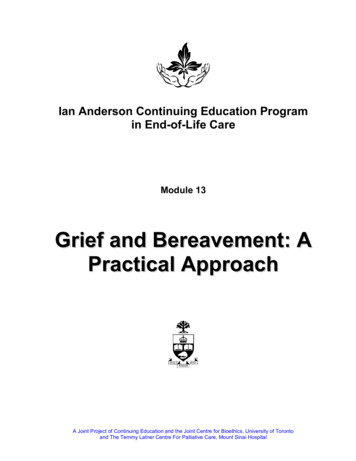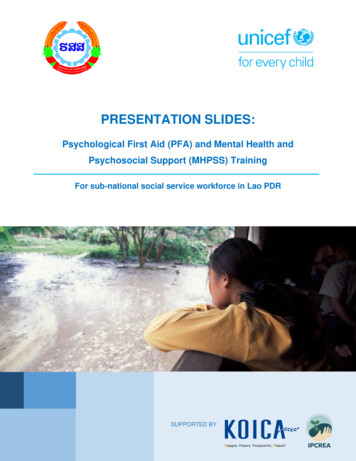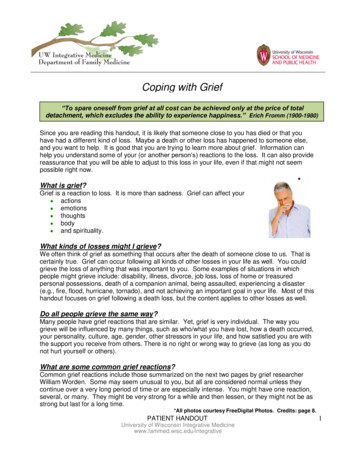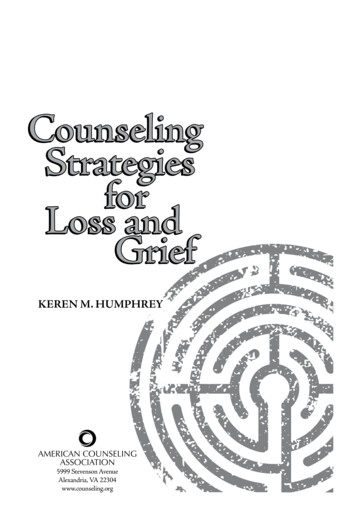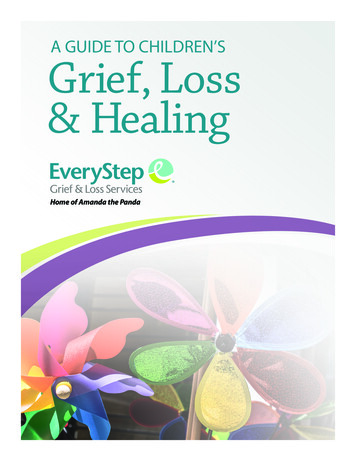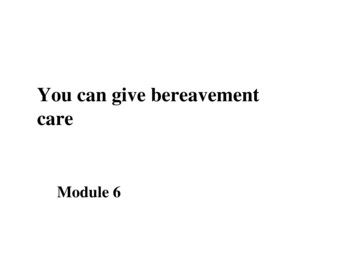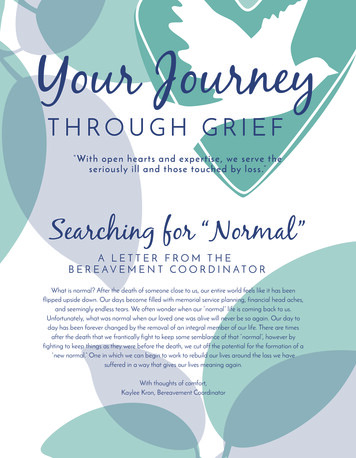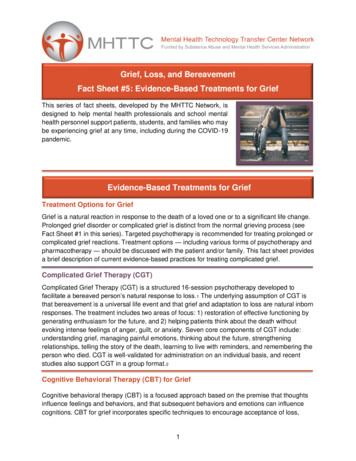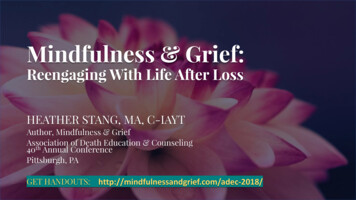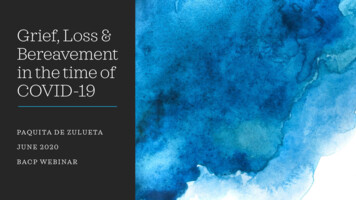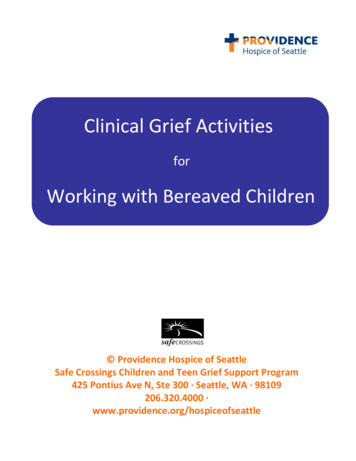
Transcription
Clinical Grief ActivitiesforWorking with Bereaved Children Providence Hospice of SeattleSafe Crossings Children and Teen Grief Support Program425 Pontius Ave N, Ste 300 · Seattle, WA · 98109206.320.4000 ·www.providence.org/hospiceofseattle
Clinical Grief ActivitiesforWorking with Bereaved ChildrenIntroduction:Each of us will face the death of a loved one at some time in our lives. As adults, we seek helpfrom family, friends, and outside supports during the grief process. But who helps a child copewith the death of a loved one? Children naturally turn to other significant persons in their lifefor support. Although children may understand and respond to illness and death differentlythan adults, helping a grieving child is not that different from helping a grieving adult. As aclinician, your interaction can have an important impact in helping a child deal with a lovedone‟s illness and death in a healthy way.The content of this publication is intended to provide clinicians with guidance in providingsupport to adult caregivers when they are faced with the task of communicating with theirchildren about death and dying. In addition, the concrete suggestions provided in the clinicalgrief activities will prove beneficial to those clinicians working directly with grieving children.Talking with Children about Death and DyingImportant questions to consider when working with bereaved children and theirfamilies:What has the child been told about the illness and/or events of the death?What is the family‟s comfort level with the child knowing details about the illness and/ordeath?What is the culture in the family regarding illness, death and sharing difficult things withchildren?What is the child‟s history with death? Has the child experienced other family member,friends and pet deaths?What are the family and child‟s past coping responses related to illness and death?If the person who dead did not live in the same home as the child, when was the last timethe child saw this person?What was the significance of the relationship to the child of the deceased love one?If the family has not yet talked with the child about circumstances of the death Always consider the culture of the family, including ethnic and religious beliefs andpractices.Educate that the child may overhear conversations and imagine things that are farworse than the truth.Children may also be picking up on the emotional atmosphere in the home and thechanges in lifestyle that have occurred as the family has adjusted to the illness anddeath.
Guidelines to Share with Adult Caregivers about How to Talk with Children Whena Death Has Occurred:A primary concern of adult caregivers is often centered on what information to sharewith children, and how to initiate difficult conversations. The following simple guidelinescan assist the caregiver in honoring their children with truth, to the best of their ability. Itis helpful to acknowledge that there is not a „right‟ or „wrong.‟ The guidelines providedare adaptable to the specific context of the family, its values, and the unique personalityof the child.Inform the child using simple details. Give general details of how the death occurred.You can begin the conversation by saying, “Something really hard happened today ”Sudden death: “Dad‟s heart stopped beating today, and he died.”Accident: “Mary was in a car accident. Her body was very badly hurt, couldn‟t be fixed,and she died.”Old age: “Grandma had gotten very, very old, her body stopped working and she died.”Terminal illness: “Because the disease couldn‟t be stopped, your dad got very, very sickand his body stopped working. Dad died.”Stillbirth: “Sometimes something causes a baby‟s body to stop working before it is born.We don‟t know why, but it is nothing anyone did or didn‟t do.”Homicide: “Your mother was killed today. Sometimes people do very bad things thathurt or kill ”Suicide – Absolute (when there is no doubt the person killed him/herself): “Your brotherkilled himself. Sometimes a person‟s mind gets very sick and doesn‟t work right, and theydon‟t understand things clearly. They may think the only way to solve their problems is tostop living, so they kill themselves. However, this is never a solution to problems. Theonly reason they thought of it is because their mind was too sick to think clearly. It‟s notanyone‟s fault that this has happened”.Suicide – Questionable: “Sometimes people take pills to relax or to sleep. Sometimesthey forget how many they have taken and think that they need more. These pills maketheir body slow down, and too many of them make their body stop working. We don‟tthink Auntie wanted to die, but that‟s what happened to her body.”Allow questions and answer them truthfully. Children process information concerning atraumatic death in small increments. Depending on the developmental maturity of the child,he/she may ask for graphic details. Answer the question asked as simply as possible. In thecase of questions about a murder, it is helpful to refer to the person who committed the act asthe “killer” instead of “a very bad person.” “Mary was shot by a killer.” Children are oftenrepetitive, asking the same questions over and over. Again, keep answers simple as well asconsistent. This helps to build trust and reassurance that you will continue to tell them thetruth.Reassure the child that they are loved. Acknowledge the significance of the relationshipand the impact the death will have on the child. “Your father loved us very much. I will be here
to take care of you.” Often children become afraid that another caregiver may die too. It ishelpful to reassure a child. “Most people do live for a long time. I plan to continue taking goodcare of myself.”Causation. It‟s important that children are reassured that they are not at fault, especially if thedeath involves an accident that they may have seen or been a part of. “Sometimes horribleaccidents happen. There‟s nothing that anyone could have done to change what happened.”Talking to children about Sadness:Children need to know why others in the family are sad.Children must be told that it is the death that has made their family members sad. Withoutan explanation, children may think the sadness is caused by something that they did orsaid.Start by saying “A very, very sad thing has happened ” or “Mommy and Daddy are sadbecause ”Modeling of sad feelings and behaviors lets children know that it‟s okay to be sad.Children also need to be taught that people express sadness in different ways (ie somemay cry, some may want alone time, some may share more than others).What the word “dead” means:Provide children with basic information about the human body to assist in understandingof alive vs. dead (i.e., heart stopped beating, lungs no longer breathe in air, brain does notthink anymore).Use language and ideas appropriate to the age of the child to communicate that a deadperson‟s body can‟t do the things it used to do. The body is no longer able to talk, walk,move, see or hear. The dead person no longer feels pain, sadness, anger or discomfort.Use the words “dead” and “died.” Avoid the use of euphemisms such as “passed away,”“left us,” and “gone on.” To a child, this may sound as if the person is taking a trip,doesn‟t want to return and can cause him/her to fear that others may leave and not return.Refer back to these biological explanations when answering a child‟s questions that arise,such as:o When will she come back? (She can‟t. She didn‟t leave; her body stoppedworking.)o Why doesn‟t she move? (She can‟t move because her body has stoppedworking.)o Why can‟t they fix him? (Once the body has stopped working, it can‟t start again.)o Is he sleeping? (No. When we sleep our body is still working, our heart is stillbeating, our lungs are still breathing and we are just resting.)o Can they hear me? (No. They could only hear you if their body was working.)Funeral/memorial service:If the service has been planned and after a thorough discussion, it is recommended thatthe child is given the choice to attend. Answering questions that children have will helpthem to feel welcome, but some children will still opt not to attend. Either choice is ok.
It is important to prepare children in advance by telling them as specifically as possiblewhat will happen. (Change the sample explanations below to fit your plans and specialtraditions.)“ will be taken from , where he died, to the funeral home. At thefuneral home, will be dressed in clothes that he/she liked and put into acasket. A casket is a box we use so that when is buried in the ground,no dirt will get on him. Because ‟s body isn‟t working any more, his/herbody won‟t move or do any of the things it used to do. The body will look like. People will come and visit us at our house and say how sorry they arethat died. After days, we will have a special ceremony toremember . At that time, the casket will be closed and buried in theground.Provide information about who will attend and what people might say or do at theservice.Describe the room in the funeral home or chapel: room, music, flowers, paintings orreligious symbols.Give details of what to expect if viewing the body in an open casket. This isespecially helpful for young children to grasp that the person is, in fact, dead.Explain that the person will be lying down, not moving, and what they will bewearing. Explain any change in appearance due to illness, weight loss, or trauma.“It‟s still Grandpa‟s body, but you know he was sick and lost a lot of weight so he willlook thinner ”Burial (If applicable, add to the above information about the service.):“Then we will go to the cemetery, where will be buried in a hole in the ground in aspot that picked out. If you like, you can come to the funeral home and visit for awhile and even go to the cemetery. You could bring something to leave in the casket withif you want.”Cremation:“After we leave the funeral home, will be taken to the crematorium. At thecrematorium, the body will be placed in a very, very hot small room which removes all thewater from the body and turns it to ash. The body is not burned in flames. Then we willtake those ashes and (scatter them, keep them in an urn, etc.). Since ‟s bodydoesn‟t work and doesn‟t feel anything, being cremated doesn‟t hurt.”
Grief Activities Based on the Safe Crossing Program Modelfor Supporting Bereaved Children and Families1. Processing the circumstances or event within the context of the child’sdevelopmental ability.oooooCreating a safe environmentAll About MeAll About My Loved One (Anticipatory or Bereavement)AnagramTimeline2. Understanding the concepts of grief and loss.o “Way – No Way” Gameo “Grief” Activityo Books helpful in talking about grief3. Identifying and understanding feelings and behaviors associated withnormal grief response.oooooFeelings WorksheetEmotional Behavioral CardsFeelings BodyInside/Outside FeelingsFeeling Concentration Game4. Identifying and practicing healthy ways to cope.ooooWhen You Get AngryWhen You Get SadLetting Go of RegretsWhat Helps?5. Honoring the relationship and establishing continuing bonds.oooooI Remember PoemCollageMemory Book or BoxMemory CandleMemory Mobile6. Identifying and accessing his or her support system.o Who Helps Me!Additional Resource: Safe Crossings Bibliography for Children, Teens andParent/Guardians.
1. Processing the circumstances or event withinthe context of the child’s developmental ability.Creating a Safe EnvironmentWho: Kids, Teens, Families, GroupsMaterials: Beanie Babies; pipe cleaners; play doughWhy: Provides a safe, non-threatening environment that is welcoming and inviting; opens andinvites discussion; materials occupy fidgety, nervous hands.How to use: Place items on the table or floor at the beginning of the visit. Invite participant(s)to use materials. For example, use pipe cleaners to create art as you are talking. Set andreview rules at each visit. Kids, teens, families or groups may have their own rules to add tothe following:1) Confidentiality: Explain that, “What is said in room stays in room.” For youngerchildren, the clinician can use the example of “top secret.” Make sure children areaware that the only time this rule may need to be broken is if children have stated theymay hurt themselves or others.2) It‟s okay to pass: Explain that conversations may be hard at times, and it is okay not toshare if the child does not wish to.3) It‟s okay to have fun and play.All About MeWho: KidsMaterials: “All About Me” worksheet; markers, crayons or colored pencilsWhy: Assists in building rapport; helps engage participant(s) in conversation about who theyare and what they like; assists counselor to know what activities may be appropriate to use inthe future.How to use: Provide a worksheet to each participant and ask participant(s) to complete.Once completed, ask participant(s) to share.All About My Loved One: Anticipatory OR BereavementWho: Kids, TeensMaterials: “All About My Loved One” worksheet; markers, crayons or colored pencilsWhy: Provides a forum to begin to share about loved ones with a serious illness or who havedied; assists counselor to understand what information participant(s) know about the seriousillness or death of their loved one.How to use: Provide a worksheet to each participant and ask participant(s) to complete.Once completed, ask participant(s) to share.AnagramWho: Kids, Teens, Families
Materials: white or colored paper; markers, crayons, colored pencilsWhy: Encourages participant(s) to introduce their loved ones and share memories; helpsparticipant(s) begin to understand and share feelings.How to Use: Invite participant(s) to either choose the name of the person who died or a wordthat describes their relationship to that person. Examples: Sarah, Mom, pappy. Haveparticipant(s) write the word down the left side of a piece of paper. Next to each letter, haveparticipant(s) write descriptive words using the letter as the first letter of the word.Example:MarvelouslyOutstandingMaker of CookiesTimelineWho: Kids, Teens, Families, GroupsMaterials: colored or plain paper; markers, crayons or colored pencils; stickersWhy: Allows participant(s) to identify positive and/or negative significant events in their lives.Alternatively, it can provide participant(s) an opportunity to review detailed information aroundan event (i.e., accident, illness or death).How to use: Have participant(s) choose a piece of colored paper and draw a line on thepaper. Lines can be curvy, straight, jagged, etc.; the uniqueness of the line reflects theuniqueness of the individual and his/her story. The beginning of the line is their date of birthand the end of the line is today‟s date. Along the line, have participant(s) make marks thatrepresent significant changes in their family, personality, friendships, homes, schools, as wellas any new responsibilities they now have because of these changes. Using stickers ormarkers, participants can write or draw pictures or symbols to represent the loss event andother changes marked on the timeline. Participants can also describe how they felt before,during and after the times marked. Provide participants with an opportunity to share theirtimelines. This can be followed by a discussion about their observations, changes, and theloss that is associated with change.Alternate: You can also focus on a smaller amount of time, such as the day before, of, and/orafter the death of the loved one. For example, start the timeline on the day they learned theirloved one was ill and end a few days after the funeral/memorial service. This can assistchildren to understand feelings related to specific memories.
2. Understanding the concepts of grief and loss.“Way – No Way” GameWho: Kids, Families, GroupsMaterials: “Way – No Way” statement sheetWhy: Provides grief education and dispels myths of death; promotes discussion about griefand loss issues.How to use: Read each statement to participant(s). Have participant(s) put a thumb up ifthey agree with the statement or a thumb down if they disagree. Discuss statements andfollow-up with the additional discussion prompts that are in parenthesis next to each statement.Variation: If participants are active, this can be played as a game. Mark a line down thecenter of the room with tape. One side of the room is the “Way” side (agree with statement)and the other side of the room is the “No Way” side (disagree with statement). All participantsstand on the center of the line at the beginning of the game. As facilitator reads statementsaloud, participant(s) stand on or jump to the side of the line that feels true for them. Again,Discuss statements and follow-up with additional discussion prompts.“Grief” ActivityWho: Kids, Teens, Families, GroupsMaterials: “Grief” worksheet; markersWhy: Provides an opportunity for participant(s) to share about their individual griefexperience; promotes discussion about the similarities and differences in the grief experiencefor different group or family members.How to use: Provide participant(s) with a copy of the “Grief” worksheet. Have participant(s)write, draw pictures and/or describe what grief is like for them. Allow participant(s) theopportunity to share their work.Helpful Books for Talking about Death and GriefWho: Kids, FamiliesMaterials: See Safe Crossings Bibliography below for age appropriate books on grief andloss.Why: Provides education about death and dying; promote conversation between children andtheir families about difficult topics in a non-threatening way.How to use: Read the book aloud, using the pictures and content to promote discussion,facilitate questions and provide support.
“Way – No Way” Game1. People die in many different ways. (Discuss some of the ways people die)2. Everything that is alive dies someday.3. My thoughts or feelings can make someone die.4. Most people live a long time before they die.5. I have seen a real dead body.6. A funeral service or memorial service is a good way to say goodbye to our loved oneswho died.7. Some people choose to be buried when they die while others chose to be cremated. (Mayneed to explain cremation first)8. People die because they were “bad”.9. Sleeping is the same as being dead. (Discuss whether people breathe, heart beats or gethungry after they die)10. Do people feel pain/hurt after they die? (Discuss that people can‟t feel pain)11. It‟s my fault that my loved one died.12. Other people sometimes say dumb things to me about my loved one who died.13. I sometimes worry about other people in my family dying.14. I sometimes worry that I might die too.15. All feelings are OK. (Discuss some feelings that children and adults may have if a lovedone has died)16. It is ok to cry.17. Can crying help sad feelings get better? (Discuss other ways that may help children gettheir feelings out)18. Sometimes I feel mad that my loved one died.19. Sometimes I feel alone since my loved one died.20. Even though my loved one died, I can still have fun and happy times.*** Statements in parenthesis are to assist clinician to expand the conversation and generatefurther discussion with participants.
3. Identifying and understanding feelings and behaviorsassociated with normal grief responses.“Feelings” WorksheetWho: Kids, Teens, Families, GroupsMaterials: “Feelings” worksheet; markers, colored pencils or crayonsWhy: Provides an opportunity to express feelings related to their grief experience; normalizefeelings associated with grief.How to use: Provide participant(s) with a feelings worksheet. Ask participant(s) to look overthe worksheet. Invite them to circle any feelings they are currently feeling. Use worksheet as adiscussion starter for talking about feelings. Ask participant(s) to share which feelings they arecurrently feeling and when they have been feeling that way. Worksheet can also be helpful forfamilies to check-in with their children.Emotional Behavioral CardsWho: Kids, Teens, Families, GroupsMaterials: Emotional Behavioral Cards; crayons or markersWhy: Facilitates discussion of grief experiences; normalizes feelings associated with grief;broadens self-awareness regarding one‟s personal grief process.How to use: Explain to participants that the feelings and behaviors on each card are feelingsand behaviors other kids and teens have said they experience.Individuals:o Have participant sort the cards into two piles: one pile with those that they haveexperienced and a second pile with those that they have not.o Counselor and participant can discuss behaviors and feelings.Family or Group:o Pass the cards around and ask participant(s) to put a check mark on any card thatdescribes a feeling or behavior they have experienced. If the cards are laminated,crayons work well for this (easy to clean and less messy than markers).o After the cards have been seen by all participants, pass several out to each participant.o Ask participants to read each of the cards in front of them and count the number ofmarks. Discuss behaviors and feelings as well as commonalities and differences.Feelings BodyWho: Kids, Teens, Families, GroupsMaterials: Piece of paper for each participant; large piece of butcher paper (for variation);markersWhy: Provides an outlet to articulate the grief experience through artistic expression; providesan opportunity to understand the manifestations of feelings in the body.
How to use: This activity should follow the previous discussion/activities related to theidentification of feelings and how/where they are experienced in one‟s body. Discuss thephysical manifestations of grief. Give a few examples, i.e., tired behind the eyes; nervous butterflies in the stomach or sweaty palms, spaced out, heart has been torn in two, etc. Haveparticipants an outline of a body on their piece of paper. For some kids or groups, it may bebetter for the clinician to draw the body ahead of time. Ask participant(s) to choose a differentcolor marker to represent each feeling. The feelings can be written or drawn on their bodydrawing. Provide an opportunity for participant(s) to share their body (the feelings they arefeeling, where in the body they feel these feelings, symbols/pictures they drewto represent(continuedon next page)these feelings).Variation: If there is a large space, cut a big piece of butcher paper the height of eachparticipant. Ask participant(s) to lie on the butcher paper and trace an outline of eachparticipant‟s body. Participant(s) can then fill in their own body with feelings as above.Inside/Outside Feelings: Paper Bag or FacesWho: Kids, Teens, Families, GroupsMaterials: Paper Bag: Brown paper lunch bags; strips of colored paper; markers, crayons orcolored pencils; tapeFaces: Paper Plates, tongue depressors, markers, staplerWhy: Identify feelings they are experiencing during their grief process; affirms feelings asnormal part of grief; provides education and understanding of how feelings may or may not beexpressed even if they are felt.How to use:Paper Bag (older kids and teens): Ask participant(s) to write down or draw a picture of all thefeelings they have felt since their loved one died. Ask them to think about which feelings theyexpress to others and explain these are called the outside feelings. Ask participant(s) to thinkabout which feeling they do not express to others but keep on the inside and explain these arecalled inside feelings. Ask participant(s) to tape outside feelings to the outside of the paperbag and put inside feelings in the inside of the bag. Invited each participant to share theirinside and outside feelings. Children can keep bags at home and change the location offeelings as the feelings that they share with others change.Faces (younger kids): Put a tongue depressor between two paper plates. Staple the twopaper plates together. Explain to participant(s) that we feel many feelings when someone inour life dies. Some of these feelings we chose to share with others and some we chose tokeep to ourselves. Ask participant(s) to draw a picture of their face with the feelings that theyshow to others on one paper plate. Ask participant(s) to draw a picture of their face with thefeelings that keep inside and do not let others see on the other plate. Invite participant(s) toshare.Feelings ConcentrationWho: Kids, Teens, FamiliesMaterials: Feelings concentration cards (2 cards of each feeling). Two sets of FeelingsFlashcards would also work well with non-readers, who could use the face pictures to help
.atvendorssuchaswww.amazon.comorWhy: Educate about feelings; Provides opportunity to share feelings and memories.How to use: Place cards face down on the table or floor. One participant at a time flips twocards over to try to find a match. When a match is identified, the participant who finds thefeelings pair is given the opportunity to share a time when he or she experienced that feelingwith their loved one or in their grief process. If the participant cannot identify a time whenhe/she experienced the feeling with their loved one, he/she can share anytime when he/sheexperienced that feeling. With younger children, you may want to use fewer pairs (ie 5 pairs).
Emotional Behavior Cards
Emotional Behavior Cards
Emotional Behavior Cards
Feelings Concentrationembarrassed ylonelylonelysadsad
Feelings usjealousangryangryafraidafraidworriedworried
Feelings redoverwhelmed overwhelmedrelievedrelievedfrustratedfrustrated
4. Identifying and practicing healthy ways to cope.“When You Get Angry” worksheetWho: Kids, Teens, FamiliesMaterials: “When You Get Angry” worksheet; pen or pencilWhy: Provides education and identification of healthy expressions of anger; promotesdiscussion for creative strategies for self care.How to use: Explain that many kids and teens you have talked to feel angry in their griefexperience. It is helpful to find safe ways to express anger that won‟t hurt one‟s self or anotherperson. Hand out the “When You Get Angry” worksheet, explaining that it has some ideas forthings to do when you feel angry. Have the participant(s) read it over and circle the ideas thatmight work for them. Ask participant(s) if they have any other ideas, and have them writedown their ideas on the page. For young children who cannot read, read each idea to themand let them share if it might helpful. At the end of the discussion, the child might want to tryone of the activities if feeling angry.“When You Get Sad” worksheetWho: Kids, Teens, FamiliesMaterials: “When You Get Sad” worksheet; pen or pencilWhy: Provides education and identification of healthy expressions of sadness; to promotediscussion for creative strategies for self care.How to use: Discuss different ways people express their sadness. Hand out the “When YouGet Sad” worksheet, explaining that it has some ideas for things to do when you feel sad.Have the participant(s) read it over and circle the ideas that might work for them. Askparticipant(s) if they have any other ideas, and have them write down their ideas on the page.For young children who cannot read, read each idea to them and let them share if it mighthelpful. At the end of the discussion, the child might want to try one of the activities if feelingsad.“Regrets: Letting Go” activityWho: Kids, Teens, Families, GroupsMaterials: white or colored paper, regret prompts, pens or markers, trash can or papershredderWhy: Provides an opportunity to identify and let go of regrets; offers an opportunity for selfreflection and the promotion of healing.How to use: Explain that the activity will be around the idea of regrets. Ask participant(s) ifthey know what the word “regret” means. After discussion, have group members close theireyes, and read aloud the following:When someone we love dies, it is normal to have thoughts that can be calledregrets. A regret is something we wish we had done differently. Some peopleregret, or feel sad, that they were not able to say goodbye or be with their special
person before he or she died. Others may regret they had an argument, or crosswords or thoughts, before their loved one died. Sometimes people even think theycaused the death to happen by something they did, said or thought. Most peoplehave a regret or two.It is important to know that there is nothing you did, said or thought that causedthe death of your loved one. Talking about our regrets with people we trust canhelp us understand that these thoughts are very normal and most people havethem. If we do this, we can then let the regrets go! I would like you to think aboutyour regrets.Let me give you a few sentence starters to help you begin:o I wish I had o If only o It was my fault o I‟m sorry that o I blame myself for When you are ready, open your eyes. Draw or write your regrets on your piece ofpaper. I will give you 10-15 minutes to work on your regrets.When group is finished, invite participants to share one or several of their regrets. After eachparticipant has shared, ask them to think about whether they are ready to let go of theirregrets. For those that are ready to let go of their regrets, tell them the time has come for theirregrets to be released.Option 1:o Invite each participant to tear their paper into many small pieces.o When they have all finished, get in a circle with each participant holding his/her piecesof paper. Count to three, and have the participants toss the pieces of paper into the airin the center of the circle like confetti. Explain that all of the brightly colored paper withthoughts of guilt, blame and regret are now released, and when regrets are outside of aperson, the colors (regrets) are beautiful, but when kept inside, the regrets are nothelpful.Option 2:o Use a paper shredder or tra
o Books helpful in talking about grief 3. Identifying and understanding feelings and behaviors associated with normal grief response. o Feelings Worksheet o Emotional Behavioral Cards o Feelings Body o Inside/Outside Feelings o Feeling Concentration

